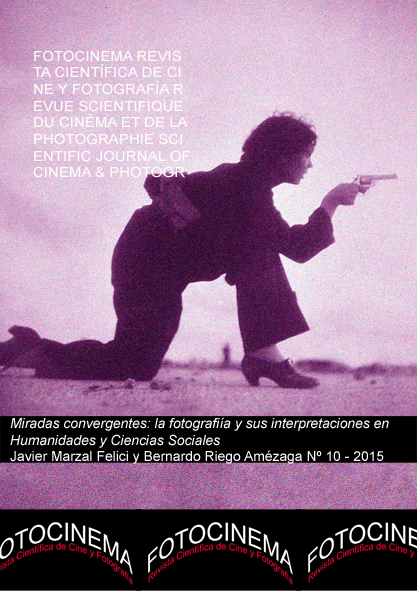Introducción al fenómeno del Selfie: valoración y perspectivas de análisis
DOI:
https://doi.org/10.24310/Fotocinema.2015.v0i10.5991Abstract
Resumen:El presente trabajo analiza uno de los fenómenos más llamativos de los últimos años en las redes sociales, que se ha hecho posible gracias a la implementación de las nuevas tecnologías en los hábitos de consumo de imágenes y la cultura del entretenimiento. Nos referimos al fenómeno del selfie, una nueva modalidad de autorretrato determinada por los avances en sectores como la óptica y las telecomunicaciones, que han puesto al servicio de los usuarios nuevos equipos de telefonía cada vez más versátiles. La creciente difusión de este tipo de fotografías exige un análisis de fenómeno, pues se trata de una práctica que conjuga aspectos relativos a la comunicación, la creatividad, los procesos de identificación y el desarrollo de nuevas formas de interrelación social. Se propone un estudio teórico desde un enfoque interdisciplinar, teniendo en cuenta que dicho fenómeno se enmarca en un contexto donde es habitual el intercambio de imágenes a través de espacios como Tumblr o Facebook. El análisis nos ha llevado a concluir, con carácter provisional, que la tecnología se ha puesto al servicio del Yo, y que la práctica del selfie acentúa la visión imaginaria que los usuarios tienen de sí mismos.
Abstract:
This paper tries to analyze one of the most striking phenomena of recent years in social networks, which has been made possible by the implementation of new technologies in consumer habits of images and entertainment culture. We are referring to the Selfie phenomenon: a new self-portrait mode determined by advances in competitive sectors such as Optics and Telecommunications, which have been serving versatile tools to the new media and Internet users. The increasing deployment of such photographs requires an analysis of the phenomenon, because it is a practice that combines aspects concerning to communication, visual creativity, the process of identifying and developing new forms of social interaction. A first theoretical study is proposed from an interdisciplinary approach, considering that this phenomenon is part of a communicative context where people can share data and images through virtual spaces such as Tumblr or Facebook. The analysis of the Selfies has led us to conclude, provisionally, that technology has been put to the service of the Ego, and Selfie practice emphasizes the imaginary perception that users have of themselves.
Palabras clave:
Fotografía; análisis de la imagen; telefonía móvil; selfie; comunicación; Internet
Keywords:
Photography; Analysis of Image; Mobile Phone; Selfie; Communication; InternetDownloads
Metrics
Publication Facts
Reviewer profiles N/A
Author statements
Indexed in
-
—
- Academic society
- N/A
- Publisher
- Universidad de Málaga
Downloads
Published
How to Cite
Issue
Section
License
All contents published in Fotocinema Revista científica de cine y fotografía are protected under the Creative Commons Attribution-NonCommercial-ShareAlike 4.0 International (CC BY-NC-SA 4.0) license. All about this license is available in the following link: <http://creativecommons.org/licenses/by-nc-sa/4.0>
Users can copy, use, redistribute, share and exhibit publicly as long as:
- The original source and authorship of the material are cited (Journal, Publisher and URL of the work).
- It is not used for comercial purposes.
- The existence of the license and its especifications are mentioned.
There are two sets of authors’ rights: moral and property rights. Moral rights are perpetual prerogatives, unrenounceable, not-transferable, unalienable, imprescriptible and inembargable. According to authors’ rights legislation, Fotocinema. Revista científica de cine y fotografía recognizes and respects authors moral rights, as well as the ownership of property rights, which will be transferred to University of Malaga in open access. The property rights are referred to the benefits that are gained by the use or the dissemination of works. Fotocinema. Revista científica de cine y fotografía is published in an open access form and it is exclusively licenced by any means for doing or authorising distribution, dissemination, reproduction, , adaptation, translation or arrangement of works.
Authors are responsable for obtaining the necessary permission to use copyrighted images.














13.png)



